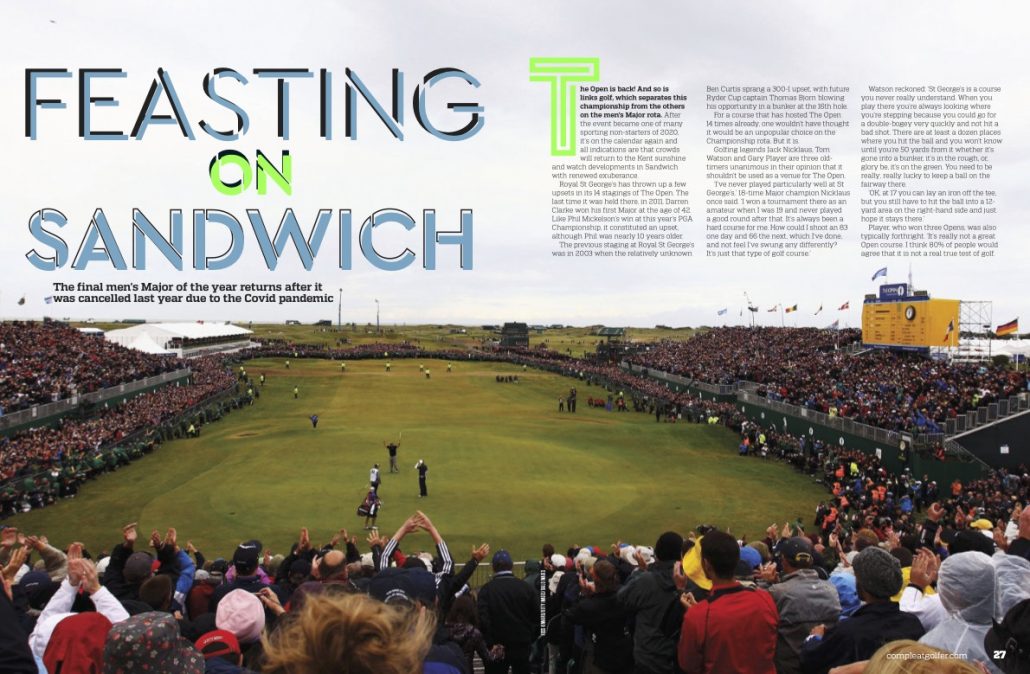The final men’s Major of the year returns after it was cancelled last year due to the Covid pandemic.
The Open is back! And so is links golf, which separates this championship from the others on the men’s Major rota. After the event became one of many sporting non-starters of 2020, it’s on the calendar again and all indications are that crowds will return to the Kent sunshine and watch developments in Sandwich with renewed exuberance.
Royal St George’s has thrown up a couple of upsets in its 14 stagings of The Open. The last time it was held there, in 2011, Northern Irishman Darren Clarke won his first Major at the age of 42. Like Phil Mickelson’s win at this year’s PGA Championship, that constituted an upset, although Phil was nearly 10 years older.
The previous staging at Royal St George’s was in 2003 when the relatively unknown Ben Curtis sprang a 300-1 upset, with future Ryder Cup captain Thomas Bjorn blowing his opportunity in a bunker at the 16th hole.
For a course that has hosted The Open 14 times already, one wouldn’t have thought it would be an unpopular choice on the Championship rota. But it is.
Golfing legends Jack Nicklaus, Tom Watson and Gary Player are three old-timers unanimous in their opinion that it shouldn’t be used as a venue for The Open.
‘I’ve never played particularly well at St George’s,’ 18-time Major champion Nicklaus once said. ‘I won a tournament there as an amateur when I was 19 and never played a good round after that. It’s always been a hard course for me. How could I shoot an 83 there one day and 66 the next, which I’ve done, and not feel I’ve swung any differently? It’s just that type of golf course.’
Watson reckoned: ‘St George’s is a course you never really understand. When you play there you’re always looking where you’re stepping because you could go for a double-bogey very quickly and not hit a bad shot. There are at least a dozen places where you hit the ball and you won’t know until you’re 50 yards from it whether it’s gone into a bunker, it’s in the rough, or, glory be, it’s on the green. You need to be really, really lucky to keep a ball on the fairway there.
‘OK, at 17 you can lay an iron off the tee, but you still have to hit the ball into a 12-yard area on the right-hand side and just hope it stays there.’
Player, who won three Opens, was also typically forthright. ‘It’s really not a great Open course. I think 80% of people would agree that it is not a real true test of golf. Should it stay on the Open rota? No, I don’t think so.’
Yet, UK Golf Guy, who runs the website www.ukgolfguy.co.uk, differs starkly with the views of the three giants of the game.
‘There are some who say that Royal St George’s is a little less than a true classic Open course. They say the bounces can be a little random and Ben Curtis’ Open victory back in the day cast a bit of a shadow on the course’s pedigree. Well, I can safely say that is a load of rubbish. This is links golf at its very very best and for me close to unbeatable.
‘The course is a brilliant one. It’s perfectly playable with pretty wide fairways and many quirks to keep you entertained all the way round. The bunkers are among the hardest I have played, on more than one occasion we had to play out sideways or backwards – a real penalty.’
For us neutrals, though, it will be a feast to be able to watch the world’s best golfers be put to the test on a course that is a traditional links layout. For all the target golf that we’ve become used to seeing on the PGA Tour during the Covid-19 pandemic period, seeing the pros negotiate holes with tricky bumps and runs and undulating fairways and greens makes for a delightful viewing menu.
KNOW THE COURSE
1st – 445 yards, par four: Tiger Woods famously started with a seven on this hole in 2003, while Jerry Kelly carded an 11 in 1993.
2nd – 421 yards, par four: Right-to-left dog-leg. Straightforward approach. Players will target the front of the green to leave an uphill putt
3rd – 239 yards, par three: Lengthy and provides a stiff test into a sizeable two-tiered green. Features the only tree on the course
4th – 491 yards, par four: One of the toughest holes. During the 1985 Open it yielded a scoring average of 4.6.
5th – 422 yards, par four: Has a split fairway. The safe shot down the right-hand side with an iron often brings a more profitable result
6th – 174 yards, par three: Four bunkers protect a long two-tiered green. Tom Watson got a hole-in-one here in 2011.
7th – 556 yards, par five: One of only two par fives. Plenty of eagles have been recorded at this hole in previous Opens.
8th – 450 yards, par four: Traditionally the toughest hole. Tee shots should be kept left to avoid two cleverly placed bunkers.
9th – 412 yards, par four: The second shot is key. Any approaches that miss left run the risk of finding two deep bunkers
10th – 415 yards, par four: Demands a precise approach, with an elevated green tricky to hold due to the fact it falls away sharply on all sides.
11th – 238 yards, par three: Originally a par four. Five bunkers surround the green, with the three on the left likely to be found regularly.
12th – 379 yards, par four: Shortest par four on the course means players can afford to take an iron from the tee.
13th – 456 yards, par four: Narrow fairway is not easy, with four bunkers lying in wait. One of them was created by a bomb in World War II.
14th – 547 yards, par five: Don’t miss right. In 1985 and 2011, the average score on the 14th was 5.19 and 5.07, and 5.3 in 2003.
15th – 496 yards, par four: Five bunkers are in play off the tee, with three more positioned in front of the green at this long par four.
16th – 162 yards, par three: The hole that proved the downfall of Thomas Bjorn in 2003. There were three holes-in-one on the 16th in 1981.
17th – 426 yards, par four: Gentle dog-leg from right to left to a fairway full of swales and humps. Distance control is crucial with the second shot.
18th – 450 yards, par four: One of the most fearsome finishing holes on The Open rota. The approach to 18 is never straightforward.
SA’S QUALIFIERS
Ernie Els (champion 2002 and 2012)
Louis Oosthuizen (champion 2010)
Christiaan Bezuidenhout (inside top 50 in the world in week 21)
Erik van Rooyen (inside top 30 in 2019 Race To Dubai standings)
Justin Harding (inside top 30 in 2019 Race To Dubai standings)
JC Ritchie (Sunshine Tour Order of Merit winner 2019-20)
Shaun Norris (inside top two on the 2019 Asian Tour moneylist)
Branden Grace (qualified from 2020 SA Open)
Jaco Ahlers (qualifying series)
OPEN NUMBERS
3 There have been three Open Championships that didn’t have a prize fund.
4 The most competitors in a single playoff, which was at Muirfield in 2002. Stuart Appleby and Steve Elkington were eliminated after four extra holes and the tournament went to sudden death between Ernie Els and Thomas Levet. The Big Easy parred the first hole of sudden-death (the 18th) to win his third Major.
6 The most victories at The Open Championship – by Harry Vardon – who also invented the overlapping grip.
8 There have been eight wire-to-wire winners, the last of which was American Jordan Spieth at Royal Birkdale in 2017, when he shot rounds of 65, 69, 65 and 69 to beat Matt Kuchar by three strokes.
8 The number of golfers who played the inaugural Open Championship at Prestwick Golf Club in 1860. This year marks the 149th staging of the tournament.
14 Courses that have hosted The Open: St Andrews, Muirfield, Royal St Georges, Royal Liverpool, Royal Troon, Royal Lytham & St Annes, Carnoustie, Royal Portrush, Royal Birkdale, Turnberry, Prestwick, Musselburgh, Royal Cinque Ports, Prince’s
15 Royal St George’s will be hosting The Open for the 15th time. It was first staged there in 1894 and most recently in 2011.
264 The lowest four-round score, achieved by Henrik Stenson at Royal Troon in 2016, after round of 68, 65, 68 and 63.
7 179 The yardage of the Royal St George’s championship course.
1949 The year the only South African won The Open at Royal St George’s – Bobby Locke.
46 The record for the most Open appearances, held by Gary Player, who is also the only golfer to win in three different decades of the 20th century.
62 Branden Grace’s 62 in the third round of the 2017 Open at Royal Birkdale is the lowest round in Major history. ‘Let’s get this out of the way,’ said Grace, opening his press conference. ‘I didn’t know what was going on at 18. I promise you.’ He had loops of 29 and 33. ‘To do it at the Open Championship is pretty special. It’s something I’ll remember forever.
£1.935-million The amount (about R37-million) that will be awarded to this year’s winner.
GOLF DURING COVID
‘There are multiple plans and multiple options. We are hoping for an audience at Royal St George’s of about 75% of capacity. But the scope of options is from 25% to 75%; that shows you the uncertainty we’re having to work with,’ R&A chief executive Martin Slumbers said. On the scenes that accompanied Phil Mickelson at the 18th hole when he won the PGA Championship. ‘We’re conscious of keeping that space around our 18th hole safe and clear, to give the players the freedom to play the final hole. We’re careful on how we move the crowds and will continue to keep them on the side on the 18th until it’s all over. Then we will allow them to move closer. I have absolutely no regrets whatsoever that we cancelled the Open last year. It was the situation we were in. We didn’t have a choice.’
This article first appeared in the July issue of Compleat Golfer







